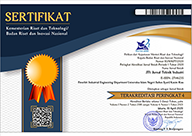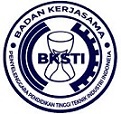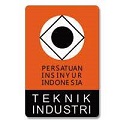Feasibility Analysis of Cicalengka Tofu Factory Expansion
Abstract
Tofu is a popular and affordable protein source widely consumed across Indonesia. The Cicalengka Tofu Factory in Bandung Regency is experiencing increasing demand, resulting in frequent overtime to meet production requirements. The factory plans to expand its production area by utilizing adjacent vacant land to address this challenge. This study evaluates the feasibility of the expansion, forecasting tofu demand until 2026 using time-series analysis with a single moving average method. The proposed expansion aims to increase production capacity from 264 to 396 tofu planks per day, requiring an investment of IDR 1,551,129,586. Financial analysis reveals that without expansion, the Net Present Value (NPV) over the next three years would be IDR 825,211,554, with an Internal Rate of Return (IRR) of 121%. With the expansion, the NPV increases to IDR 972,087,040, with an IRR of 43%. Incremental IRR analysis further supports the expansion, yielding an IRR of 22%, which exceeds the Minimum Attractive Rate of Return (MARR) of 16.36%. These findings validate the expansion plan as a financially viable strategy to enhance production capacity, minimize overtime, and ensure the factory’s long-term sustainability.
Keywords: Feasibility Analysis, Expansion, Cicalengka Tofu Factory, Incremental Analysis
Full Text:
PDFReferences
E. Salim, Kiat Cerdas Wirausaha Aneka Olahan Kedelai. Yogyakarta: Lily Publisher, 2012.
Karnadi, “Konsumsi Tahu dan Tempe per Kapita di Indonesia Naik pada 2021.” Accessed: Dec. 20, 2023. [Online]. Available: https://dataindonesia.id/agribisnis-kehutanan/detail/konsumsi-tahu-dan-tempe-per-kapita-di-indonesia-naik-pada-2021
M. Faisal, A. Gani, F. Mulana, and H. Daimon, “Treatment and Utilization of Industrial Tofu Waste in Indonesia,” Asian Journal of Chemistry, vol. 28, no. 3, pp. 501–507, 2016, doi: 10.14233/ajchem.2016.19372.
P. Putro, “Kontribusi Pengrajin Industri Kecil Tahu dalam Peningkatan Kehidupan Sosial Ekonomi Keluarga ( Studi Kasus Masyarakat Desa Madegondo, Kecamatan Grogol, Kabupaten Sukoharjo),” Sosialitas: Jurnal Ilmiah Pendidikan Sosiologi-Antropologi, 2013.
D. Herdiansyah, Reza, Sakir, and Asriani, “Kajian Proses Pengolahan Tahu: Studi Kasus Industri Tahu di Kecamatan Kabangka Kabupaten Muna,” Agritech, vol. XXIV, no. 2, pp. 1411–1063, Dec. 2022.
H. Umar, Metode Penelitian untuk Skripsi dan Tesis Bisnis, 2nd ed. RajaGrafindo Persada, 2008.
A. K. Bansal, “Feasibility analysis and business plan,” 2023. doi: 10.1016/B978-0-12-816109-8.00029-5.
N. M. P. Bocken, “Circular business models for the fastmoving consumer goods industry: Desirability, feasibility, and viability,” Sustain Prod Consum, vol. 30, pp. 799–814, 2022, doi: 10.1016/j.spc.2022.01.012.
Suliyanto, Studi Kelayakan Bisnis. Yogyakarta: Andi Offset, 2010.
I. M. Adnyana, Studi Kelayakan Bisnis. Jakarta: LPU-UNAS, 2020.
R. Nurul Ichsan, L. Nasution, and S. Sinaga, Studi Kelayakan Bisnis (Business Feasibility Study), 1st ed. Medan: CV Manhaji, 2019.
S. Heri Winarno, “Analisa Aspek Teknik: SuatuPendekatan dalam Menilai Kelayakan Proyek,” LPPM BSI Jakarta, vol. VI, no. 1, pp. 1–8, Jan. 2008.
U. Ramdhani, Mirnawati, K. K, and I. Kurniawan, “Aspek Teknis dan Teknologi,” Makassar, 2021.
Kenneth Booth, “How to Choose the Right Equipment for Your Manufacturing Business,” BDC Magazine. Accessed: Feb. 16, 2024. [Online]. Available: https://bdcmagazine.com/2021/07/How-to-Choose-the-Right-Equipment-for-Your-Manufacturing-Business/
S. H. Baik, “Business Feasibility Study for Storage-Based Customer Flexibility Platform of Load-Serving Entity,” IEEE Access, vol. 9, pp. 83535–83550, 2021, doi: 10.1109/ACCESS.2021.3087134.
E. Jelisic, “A novel business context-based approach for improved standards-based systems integration—a feasibility study,” J Ind Inf Integr, vol. 30, 2022, doi: 10.1016/j.jii.2022.100385.
Y. Wahyu Pambudi, “Analisis Beban Kerja Karyawan dengan Metode Full Time Equivalent (Studi Kasus UKM Unlogic Projeck),” S1 Thesis, Universitas Islam Indonesia, Yogyakarta, 2017.
J. An, “Development of the business feasibility evaluation model for a profitable P2P electricity trading by estimating the optimal trading price,” J Clean Prod, vol. 295, 2021, doi: 10.1016/j.jclepro.2021.126138.
T. Mahl, “Dashboard-supported approach for feasibility and benefit analysis of Product-Service System-driven business models,” 2022. [Online]. Available: https://www.scopus.com/inward/record.uri?partnerID=HzOxMe3b&scp=85142863579&origin=inward
A. Supriadi et al., Studi Kelayakan Bisnis (Tinjauan, Teori, dan Praktis), 1st ed. Bandung: Widina Bhakti Persada, 2021. [Online]. Available: www.penerbitwidina.com
T. Purwana, Studi Kelayakan Bisnis. Depok: RajaGrafindo Persada, 2016.
L. Dominici, “Ecologically-oriented business strategy for a small-size rice farm: Integrated wetland management for the improvement of environmental benefits and economic feasibility,” Science of the Total Environment, vol. 838, 2022, doi: 10.1016/j.scitotenv.2022.156604.
M. Giles, “Usability and feasibility of a take-home methadone web-application for opioid treatment program patients: A Small Business Innovation Research mixed methods study,” Journal of Substance Use and Addiction Treatment, vol. 157, 2024, doi: 10.1016/j.josat.2023.209181.
S. Jenderal - Kementerian Pertanian, “Statistik Konsumsi Pangan Tahun 2023,” Jakarta, Dec. 2023.
DOI: http://dx.doi.org/10.24014/jti.v10i2.31540
Refbacks
- There are currently no refbacks.
Copyright (c) 2025 Adelia Shanty Alam, Farda Hasun, Nanang Suryana

This work is licensed under a Creative Commons Attribution-NonCommercial-ShareAlike 4.0 International License.
Jurnal Teknik Industri
P-ISSN 2460-898X | E-ISSN 2714-6235
Published by:
Industrial Engineering Department
Universitas Islam Negeri Sultan Syarif Kasim Riau, Indonesia
Office Address:
H.R. Soebrantas KM 15.5, Tampan, Pekanbaru, Riau, Indonesia 28293
email: jti.fst@uin-suska.ac.id
Indexed by:
JTI : Jurnal Teknik Industri under a Creative Commons Attribution-NonCommercial-ShareAlike 4.0 International License.

















